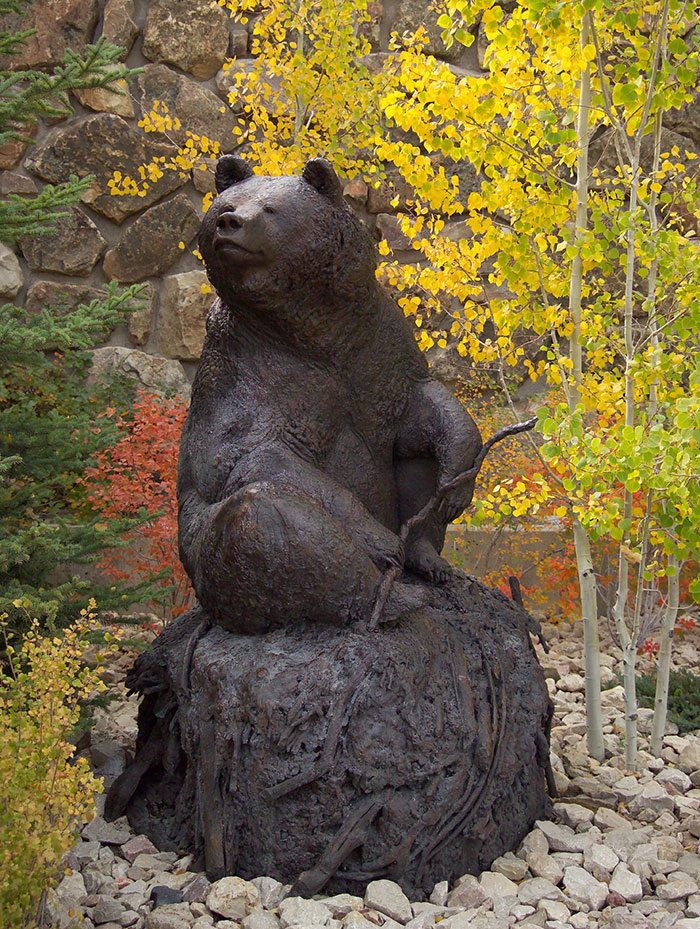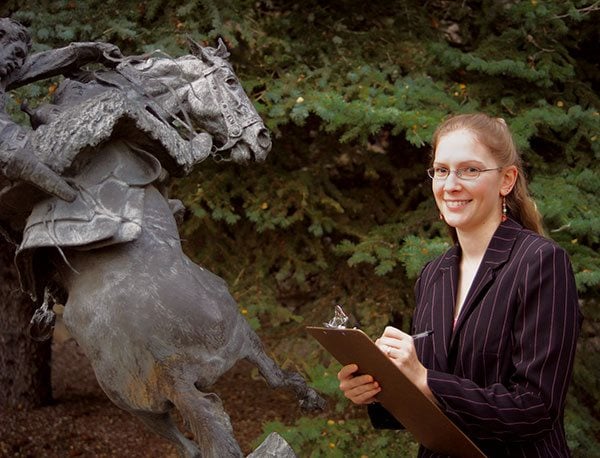Originally published in Points West magazine
Winter 2006
A Celebration of the American West through Outdoor Sculpture: Art and the Elements
By Christine Brindza, former Curatorial Assistant, Whitney Western Art Museum
Photographs by former Photographers Chris Gimmeson and Sean Campbell
“Come! See what we have to offer!”
With Bob Scriver’s sculpture of William F. “Buffalo Bill” Cody stationed like an overseer at the entrance to the Buffalo Bill [Center of the West], it’s as if the Grand Showman himself beckons visitors—and that’s just the beginning.
The spirit of the American West comes alive through the Center’s outdoor sculpture collection. With more than 20 bronze and steel sculptures, the assemblage features famous Americans, Native American subjects, plants, and wildlife which are instrumental to the story of the West, past and present. Located throughout the Center’s grounds, as well as in the Braun and Cashman Greever gardens, these works of art contribute to the cultural, historical, and natural legacy for future generations to understand and conserve.
Five years after Buffalo Bill’s death in 1917, a special committee from Cody, Wyoming commissioned Gertrude Vanderbilt Whitney (1875 – 1942), a renowned artist and contributor to the arts, to create the first outdoor sculpture of the Center’s collection. Her work, Buffalo Bill—The Scout, was dedicated in 1924. The Center has displayed and maintained this representation of “Buffalo Bill” for more than 80 years.
Buffalo Bill—The Scout is the cornerstone of the Center’s Whitney Western Art Museum collection and a major highlight of the outdoor sculptures. This monumental bronze shows a young Buffalo Bill as a scout for the U.S. Army, mounted on horseback, peering down a trail, his arm lifted forward with rifle in hand to signal cavalry troops to follow. Whitney was also responsible for the creation of the granite base on which the sculpture sits. Buffalo Bill—The Scout is strategically placed with the mountains and natural setting as a backdrop. Today, in its position at the west end of Cody’s Sheridan Avenue, just northwest of the Center grounds, The Scout remains a symbol of the rich history of the West and an emblem of Cody.
As the Center continued to expand and develop through the years, Montana artist Bob Scriver (1914 – 1999) was engaged to create a monumental bronze of Buffalo Bill. Scriver thoroughly researched the history of Cody, and decided to portray him as a mature gentleman, wearing his Wild West garb and holding a rifle. The result, Buffalo Bill—Plainsman, was dedicated in 1977. Since 1989, Scriver’s work has greeted every visitor to the Center as they pass through the entrance.
The influences of Native American cultures past and present are significant to the history of the American West, and can be found in sculpture. For example, Buffalo Prayer by James Earle Fraser (1876 – 1953), depicts a dramatic and emotional Native American medicine man standing in reverent prayer. This piece was inspired by Fraser’s witness to a “medicine man, or counselor of the tribe, make his prayer. It was for the return of the buffalo,” according to Patricia Janis Broder’s Bronzes of the American West.
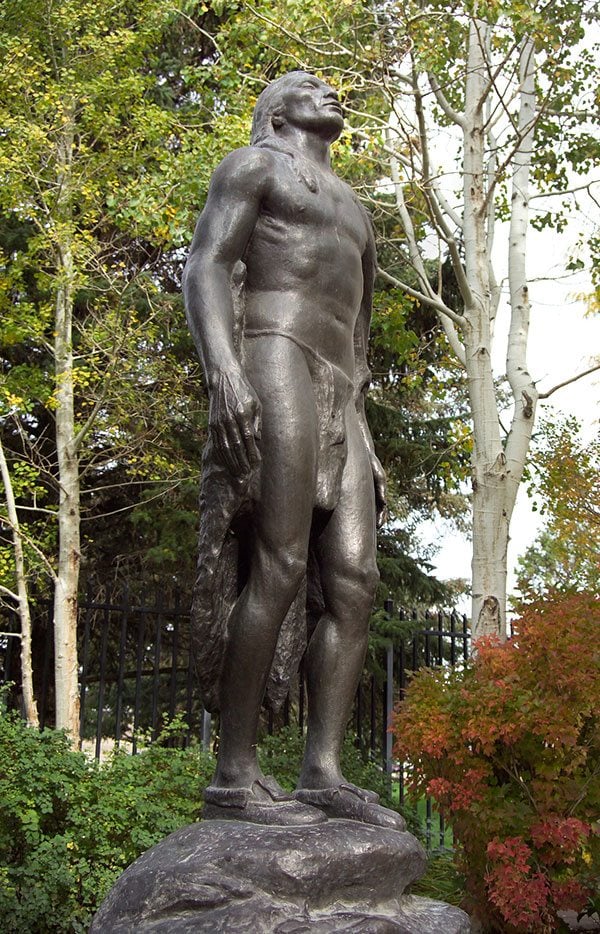
Fraser modeled this work about 1917, but didn’t copyright it until 1931 when he wrote, “It is one of the things I have always thought of as among my best pieces of sculpture.” The bronze in the Center’s collection was cast posthumously in 1968. Buffalo Prayer, installed in 1986, is located in the Braun Garden, accessible through the C.enter of the West.
The Native American woman who served as interpreter for Lewis and Clark’s Corps of Discovery, today known as Sacagawea or Sacajawea, is an important historical figure in American history, especially of the West. Variant spellings of Sacagawea/Sacajawea are meaningful to interpretation. Lewis and Clark identified her as “Bird Woman,” a woman of the “Snake” (Shoshone) nation who had been captured by the Hidatsa Indians of Knife River, North Dakota. The etymology of Sacagawea in the Hidatsa language separates “sacaga” (bird) and “wea” (woman). However, the modern day Shoshone claim her name as “Sacajawea,” which means “Boat Launcher” in their language. Artists such as Harry Jackson and R.V. Greeves use these spellings to identify the figures in their sculpture, conscious of the value of the name of this beloved American heroine.
Harry Jackson (b. 1924) began planning his Sacagawea, a monumental tribute, in the mid-1970s. The result was a painted bronze of the Native American woman and her child draped in a flowing red and white striped blanket. Jackson, well known for his masterful bronzes of western themes throughout his long career, painted and sculpted in different styles, including abstract expressionism and realism. This sculpture was graciously donated to the Center in 1980 and resides in the Cashman Greever Garden. (For more information about Jackson and his works, see the Fall 2006 edition of Points West.)
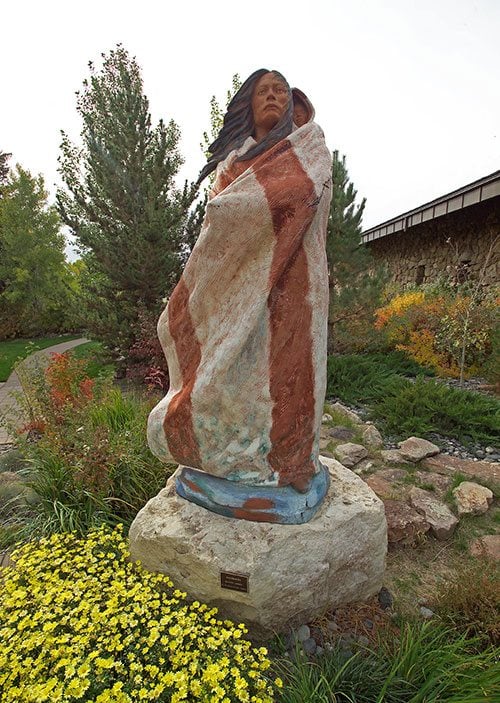
Sacajawea is also rendered in R.V. Greeves’s (b. 1935) bronze, Bird Woman (Sacajawea), 2001. Greeves’s work depicts her as a mother with her infant son, Jean Baptiste Charbonneau, in a cradleboard on her back. This sculpture captures the significant roles of Native American women in the West. Bird Woman (Sacajawea) is located on the Robbie Powwow Garden Grounds.
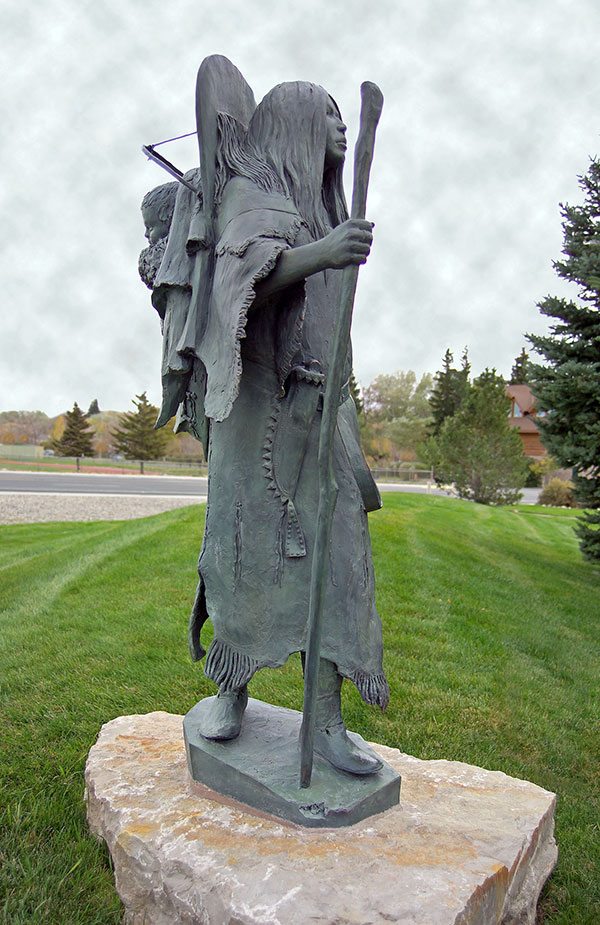
Other Greeves sculptures are currently on view at the Center as well. The Unknown, 1985, located in the Braun Garden, portrays several Plains Indian subjects representing “mankind’s awareness of this earth and each other.” It was also the first of Greeves’s work to be on display in the Center’s gardens. His Crazy Horse, 1997, also in the Braun Garden, depicts the visionary leader and legendary warrior of the Lakota nation, and Washakie—Chief of the Shoshone, 1999, located on the Robbie Powwow Garden Grounds, characterizes the Eastern Shoshone’s principal chief from 1840 to 1900.

Herb Mignery (b. 1937), an artist descended from a family of cattle ranchers, defines the people of the West by the cowboy’s spirit of courage, loyalty, and camaraderie. In his bronze, Code of the West, 1998, these values are symbolized as two cowboys on horseback shake hands. Mignery frequently depicts the unsung western heroes in everyday activities as they help to shape the modern West. The Center received Code of the West as a gift and installed it outdoors in 2001. [Originally located south of the Center, it now has a prominent place at the Center’s northwest corner].
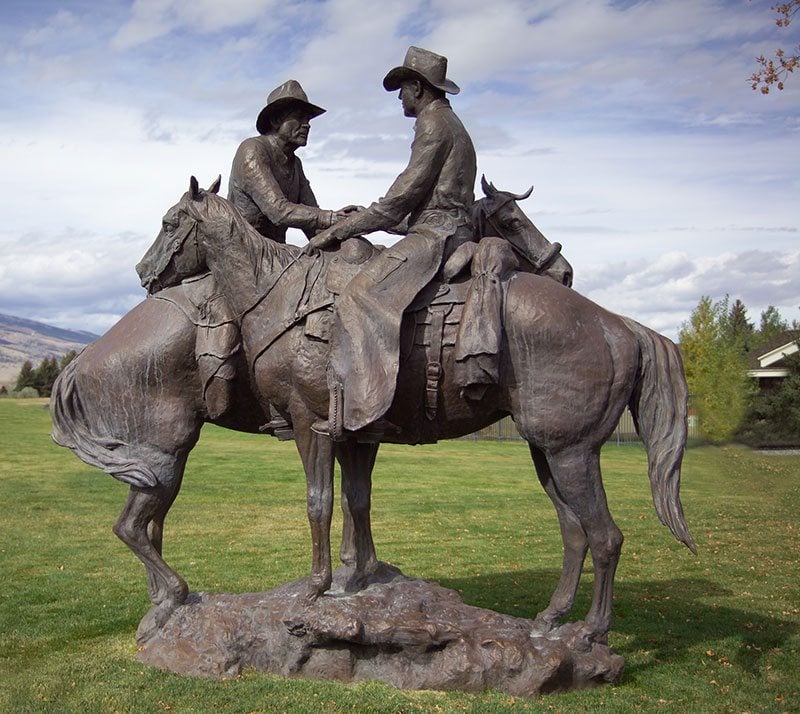
In 1978, Edward J. Fraughton (b. 1939) created a small working model for his monumental sculpture, Spirit of Wyoming. When finished, the larger sculpture was installed on the Wyoming state capitol grounds in Cheyenne. The final version of this work weighs 4,500 pounds and stands over 18 feet high. The working model, which the artist used during the initial conception of this work, was cast in bronze. Thirty casts were made; number 8 (height of 43 inches) is now on loan to the Center and is located in the Cashman Greever Garden.

Fraughton’s artistic interests are primarily cowboys and horses. In Donald Hagerty’s Leading the West, Fraughton said, “The cowboy comes closest to being a Greek centaur, man and horse working together almost as one body.”
For generations, artists have been fascinated with the flora and fauna, plant and wildlife that are characteristic of the West. Several paintings and sculptures of these subjects can be found in the Whitney Gallery of Western Art. However, the wildlife sculptures by Michael Coleman (b. 1946) exemplify the awe-inspiring world of nature in bronze.

Two of his works, September, 2001, and Big Hal, 2003, were donated to the Center and are located on either side of its entrance.
September, a bronze moose, stands as a prime example of the artist’s work in this medium. In Prix de West 2000, Coleman explained, “A Bull Moose, what a Beast! He can crash through the timber like a locomotive or sneak out the other side like a shadow. September in the Rut. One thing on his mind.” Big Hal, a bronze of a grizzly bear sitting on top of a beaver dam, was installed in early 2001 [and is currently on loan to Cody’s Yellowstone Regional Airport].
As research, the artist spent hours observing the appearance and behavior of his subject animals. Dimming Trails of Other Days, 2004, Coleman’s sculpture of bison standing in a wallow, is located in the Cashman Greever Garden.
Five extraordinary wildlife sculptures by T.D. Kelsey (b. 1946) are also on view throughout the Center grounds. As a sculptor of western subjects with a passion for wildlife, Kelsey creates moose, elk, bison, and other animal figures in bronze. Kelsey’s Daddy Long Legs, 1995, and Swamp Donkey, 1996, both illustrate life-size moose in natural poses. Royal Challenge, 1991, depicts two elk in a head-to-head competition, and Testing the Air, 1997, is representative of a larger-than-life bull elk with his head held high. The artist captures bison shedding winter coats in Changing of Seasons, 1994. Kelsey has deep-rooted interests in the conservation of wildlife, which inspires many of his works.
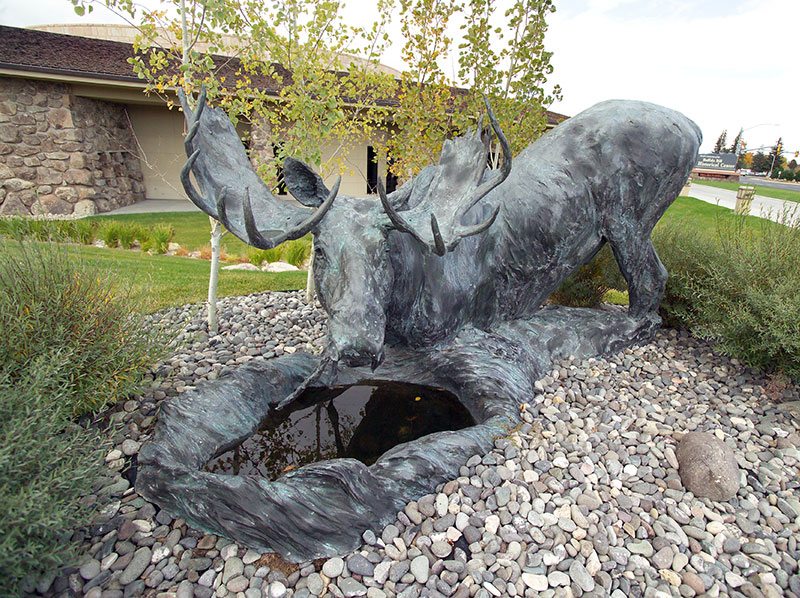
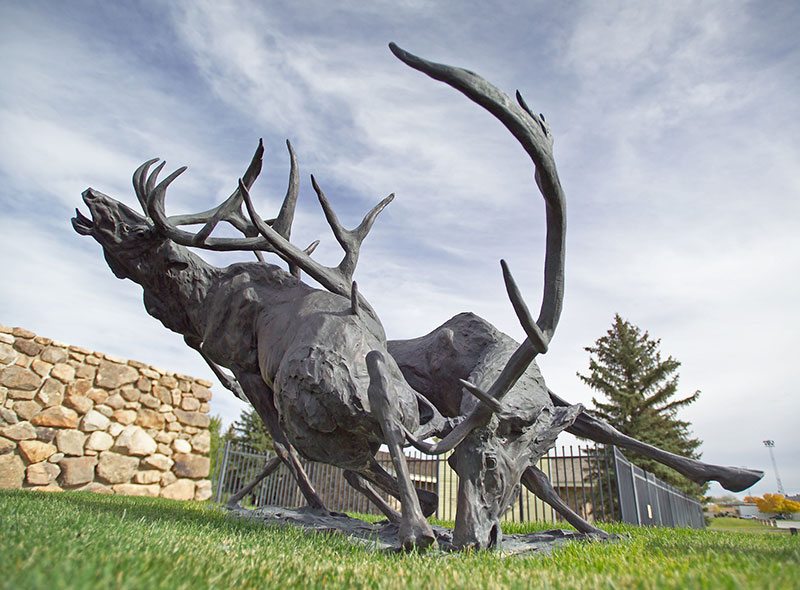
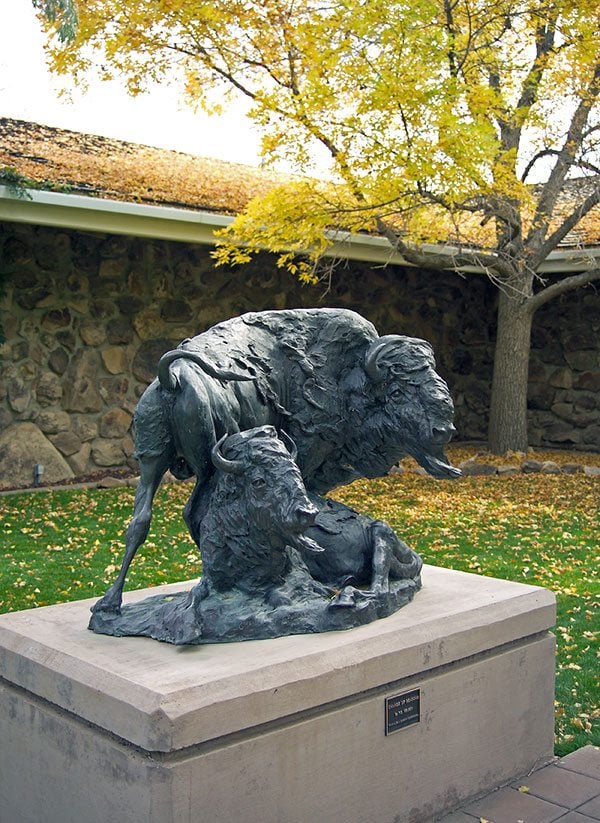
Charles Ringer (b. 1948) submitted his Prickly Pear, a large-scale, steel prickly-pear cactus, to the 2004 Buffalo Bill Art Show and Sale. Avid western art enthusiasts purchased the piece and donated it to the Center where it is now on display in front of the Draper Natural History Museum. As intended by the artist, after being placed outside exposed to the elements, the sculpture began to rust. Today, the original highly polished surface has changed to a warm red. Ringer, a professional steel sculptor, is known for his imaginative creations, which often have an organic quality. As Ringer tells it, he found his inspiration while walking through the foothills of the Beartooth Mountains and stepping on a prickly pear.
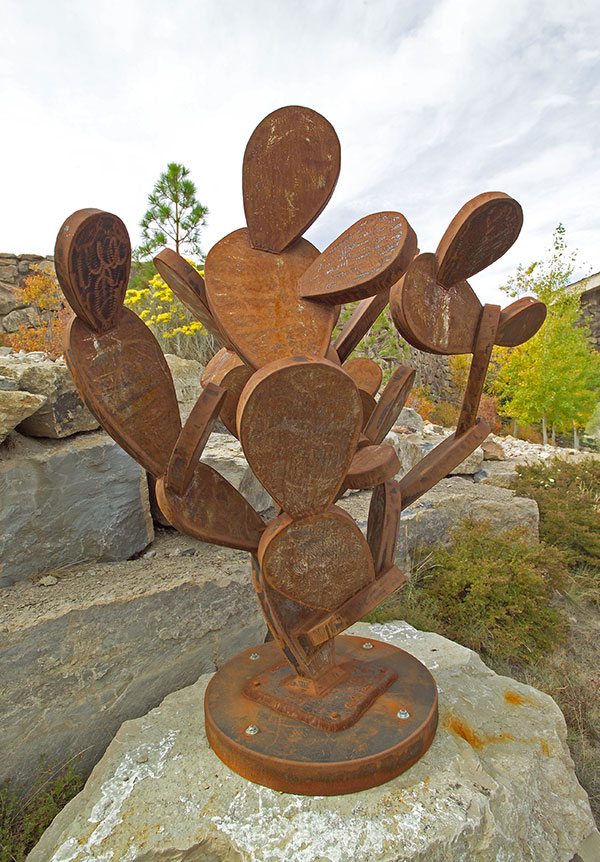
Caring for outdoor sculptures is no easy task. Maintaining these works in public places to keep them in outstanding condition takes time and resources. Outdoor sculptures are exposed to the elements of rain, snow, and sun, which, over time, can result in deterioration and may require conservation measures. In addition, humans can pose a threat to these works of art when they venture to touch, climb, and vandalize sculpture. Man-made pollutants in the air also pose a threat. Still, increased public awareness of how to treat sculpture is sure to preserve the quality of these works of art for the future.
Clearly, the West of past and present comes together at the Buffalo Bill Center of the West. Sculpture is only one outlet of many that explores the legacy of American Western culture and history. Through education and preservation, any visitor to the Center can be enriched by the wonders of the West.
One need only roam through the five museums and learn about a wide range of western topics, or read a book in the McCracken Research Library, to find the ever-present spirit of the West alive and well at the Center of the West.
Outdoor Sculpture Photo Credits
Gertrude Vanderbilt Whitney (1875 – 1942), Buffalo Bill—The Scout, 1924, cast by Roman Bronze Works, N.Y. Bronze, 149 inches. Gift of the artist. 3.58. Photo by Sean Campbell.
Bob Scriver (1914 – 1999), Buffalo Bill—Plainsman, 1976, cast by Modern Art Foundry, N.Y. Bronze, 86.5 x 62 x 50.25 inches. 12.77. Photo by Sean Campbell.
James Earle Fraser (1876 – 1953), Buffalo Prayer, modeled ca. 1917, copyrighted 1931, cast posthumously 1968, cast 1/2 by Modern Art Foundry, New York, N.Y. Bronze, 107.5 inches. Gift of William E. Weiss. 51.72. Photo by Chris Gimmeson.
© Harry Jackson Trust 2006. All rights reserved. Harry Jackson (b. 1924), Sacagawea, 1980, cast by Wyoming Foundry/Studios Camaiore Italy. Painted bronze, 114 inches. Gift of Mr. and Mrs. Richard J. Cashman. 5.80. Photo by Sean Campbell.
R.V. Greeves (b. 1935), Bird Woman (Sacajawea), 2001, cast 5/10. Bronze, 72 x 24 x 16 inches. Gift of Carlene M. Lebous and C. Harris Haston and of Keith and Bobbi Richardson. 10.05. Photo by Chris Gimmeson.
R.V. Greeves (b. 1935), The Unknown, 1985. Bronze, 108 x 92 x 90 inches. Gift of Marjorie May Braun through the Braun Foundation. 69.86. Photo by Sean Campbell.
Herb Mignery (b. 1937), Code of the West, 1998. Bronze, 140 x 137 x 72 inches. Gift of Mike Kammerer/Code of the West Foundation. 9.01. Photo by Chris Gimmeson.
Edward Fraughton (b. 1939), Spirit of Wyoming, 1978 – 1986, original working model for monument, cast 8/30. Bronze, 43 inches. Loan from Private Collection. L.13.2001.1. Photo by Chris Gimmeson.
Michael Coleman (b. 1946), September, 2001, cast 4/9, cast by Baer Bronze, Springville, UT. Bronze, 94 x 126 inches. Gift of Naoma and Hal Tate. 7.01. Photo by Chris Gimmeson.
Michael Coleman (b. 1946), Big Hal, 2003. Bronze, 84 x 55 x 60 inches. Gift of Jim and Kathy Taggart, 6.04. Photo by Chris Gimmeson.
T.D. Kelsey (b. 1946), Royal Challenge, 1991, cast 1/7. Bronze, 60 x 60 x 120 inches. The Sidni Kelsey Collection Loan. 14.12.8. Photo by Sean Campbell.
T.D. Kelsey (b. 1946), Swamp Donkey, 1996, cast 1/7. Bronze, 57 x 119 x 48 inches. The Sidni Kelsey Collection Loan. 14.12.7. Photo by Sean Campbell.
T.D. Kelsey (b. 1946), Change of Seasons, 1994, cast 6/10. Bronze, 45.5 x 60 x 34 inches. Gift of Allen & Company Incorporated. 2.95. Photo by Sean Campbell.
Charles Ringer (b. 1948), Prickly Pear, 2004. Steel, 60 x 56 x 56 inches. Gift of Howard and Lili Ann Camden. 5.05. Photo by Sean Campbell.
Post 050



